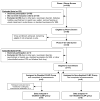Differences in brain structure and function in older adults with self-reported disabling and nondisabling chronic low back pain
- PMID: 20609128
- PMCID: PMC2925166
- DOI: 10.1111/j.1526-4637.2010.00899.x
Differences in brain structure and function in older adults with self-reported disabling and nondisabling chronic low back pain
Abstract
Objective: The primary aim of this pilot study was to identify structural and functional brain differences in older adults with self-reported disabling chronic low back pain (CLBP) compared with those who reported nondisabling CLBP.
Design: Cross-sectional.
Participants: Sixteen cognitively intact older adults, eight with disabling CLBP and eight with nondisabling CLBP. Exclusions were psychiatric or neurological disorders, substance abuse, opioid use, or diabetes mellitus.
Methods: Participants underwent: structural and functional brain MRI; neuropsychological assessment using the Repeatable Battery for the Assessment of Neuropsychological Status, Trail Making Tests A and B; and physical performance assessment using the Short Physical Performance Battery.
Results: In the disabled group, there was significantly lower white matter (WM) integrity (P < 0.05) of the splenium of the corpus callosum. This group also demonstrated activation of the right medial prefrontal cortex at rest whereas the nondisabled demonstrated activation of the left lateral prefrontal cortex. Combined groups analysis revealed a strong positive correlation (r(s) = 0.80, P < 0.0002) between WM integrity of the left centrum semiovale with gait-speed. Secondary analysis revealed a strong negative correlation between total months of CLBP and WM integrity of the SCC (r(s) = -0.59, P < 0.02).
Conclusions: Brain structure and function is different in older adults with disabling CLBP compared with those with nondisabling CLBP. Deficits in brain morphology combining groups are associated with pain duration and poor physical function. Our findings suggest brain structure and function may play a key role in chronic pain related disability and may be important treatment targets.
Figures




Comment in
-
Identifying mechanisms underlying the pain and disability relationship in later life: what role does the brain play?Pain Med. 2010 Aug;11(8):1144-5. doi: 10.1111/j.1526-4637.2010.00921.x. Pain Med. 2010. PMID: 20704663 No abstract available.
Similar articles
-
White matter hyperintensity burden and disability in older adults: is chronic pain a contributor?PM R. 2013 Jun;5(6):471-80; quiz 480. doi: 10.1016/j.pmrj.2013.03.004. Epub 2013 Mar 7. PM R. 2013. PMID: 23474209 Free PMC article.
-
Chronic pain is associated with brain volume loss in older adults: preliminary evidence.Pain Med. 2008 Mar;9(2):240-8. doi: 10.1111/j.1526-4637.2008.00412.x. Pain Med. 2008. PMID: 18298708
-
The relationship between pain, neuropsychological performance, and physical function in community-dwelling older adults with chronic low back pain.Pain Med. 2006 Jan-Feb;7(1):60-70. doi: 10.1111/j.1526-4637.2006.00091.x. Pain Med. 2006. PMID: 16533199
-
The Relationship Between Structural and Functional Brain Changes and Altered Emotion and Cognition in Chronic Low Back Pain Brain Changes: A Systematic Review of MRI and fMRI Studies.Clin J Pain. 2018 Mar;34(3):237-261. doi: 10.1097/AJP.0000000000000534. Clin J Pain. 2018. PMID: 28719509
-
Multivariable analysis of the relationship between pain referral patterns and the source of chronic low back pain.Pain Physician. 2012 Mar-Apr;15(2):171-8. Pain Physician. 2012. PMID: 22430655 Review.
Cited by
-
Disrupted interhemispheric functional coordination in patients with chronic low back-related leg pain: a multiscale frequency-related homotopic connectivity study.J Pain Res. 2019 Aug 28;12:2615-2626. doi: 10.2147/JPR.S213526. eCollection 2019. J Pain Res. 2019. PMID: 31695477 Free PMC article.
-
Accelerated brain aging in chronic low back pain.Brain Res. 2021 Mar 15;1755:147263. doi: 10.1016/j.brainres.2020.147263. Epub 2021 Jan 7. Brain Res. 2021. PMID: 33422525 Free PMC article.
-
Evaluating Cortical Alterations in Patients With Chronic Back Pain Using Neuroimaging Techniques: Recent Advances and Perspectives.Front Psychol. 2019 Nov 14;10:2527. doi: 10.3389/fpsyg.2019.02527. eCollection 2019. Front Psychol. 2019. PMID: 31798496 Free PMC article. Review.
-
Resting-state functional connectivity patterns are associated with worst pain duration in community-dwelling older adults.Pain Rep. 2021 Dec 8;6(4):e978. doi: 10.1097/PR9.0000000000000978. eCollection 2021 Nov-Dec. Pain Rep. 2021. PMID: 34901680 Free PMC article.
-
Chronic Pain in the Elderly: Mechanisms and Distinctive Features.Biomolecules. 2021 Aug 23;11(8):1256. doi: 10.3390/biom11081256. Biomolecules. 2021. PMID: 34439922 Free PMC article. Review.
References
-
- Edmond SL, Felson DT. Prevalence of back symptoms in elders. J Rheumatol. 2000;27:220–225. - PubMed
-
- Helme RD, Gibson SJ. The epidemiology of pain in elderly people. Clinics in Geriatric Medicine. 2001;17:417–31. - PubMed
-
- Weiner DK, Haggerty CL, Kritchevsky SB, Harris T, Simonsick EM, Nevitt M, Newman A. How does low back pain impact physical function in independent, well-functioning older adults? Evidence from the Health ABC Cohort and implications for the future. Pain Med. 2003;4:311–20. - PubMed
-
- Edmond SL, Felson DT. Function and back symptoms in older adults. J Am Geriatr Soc. 2003;51:1702–1709. - PubMed
Publication types
MeSH terms
Grants and funding
LinkOut - more resources
Full Text Sources
Medical
Research Materials

